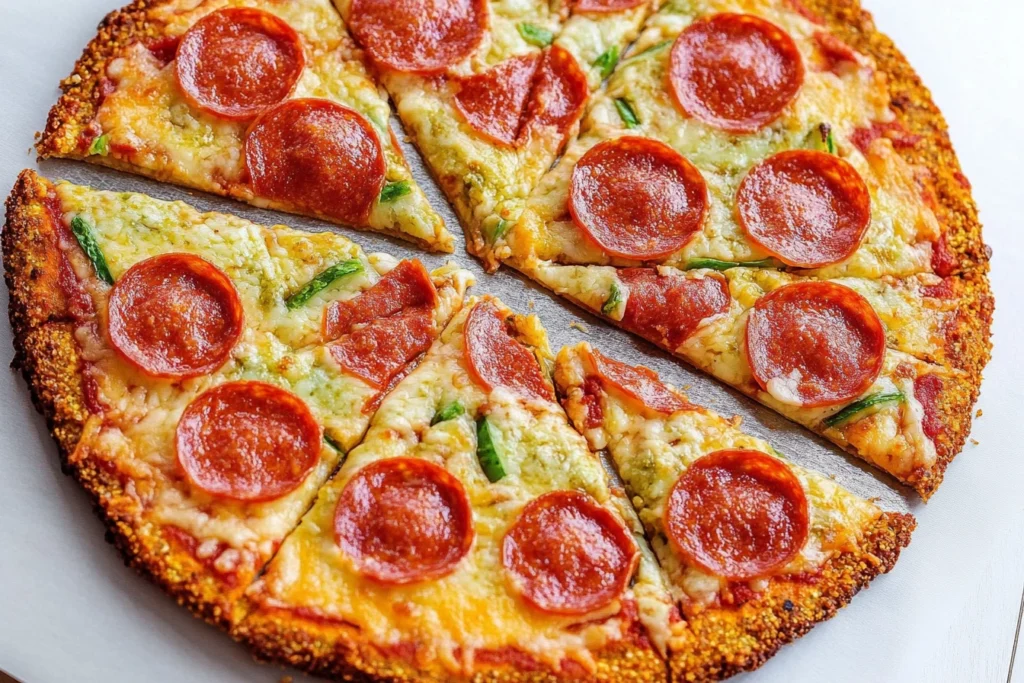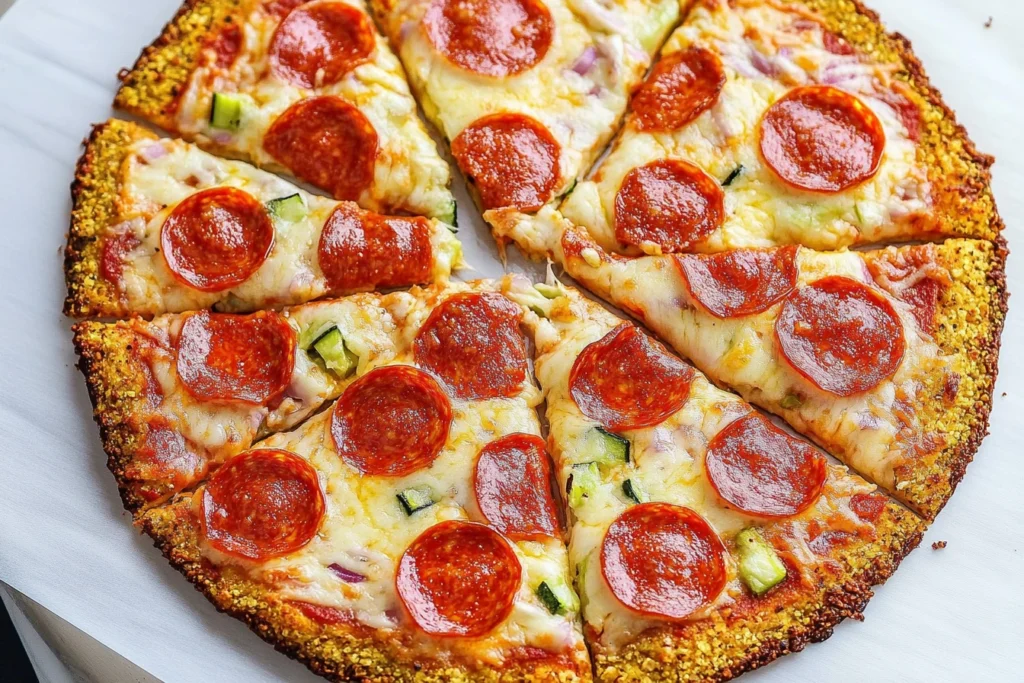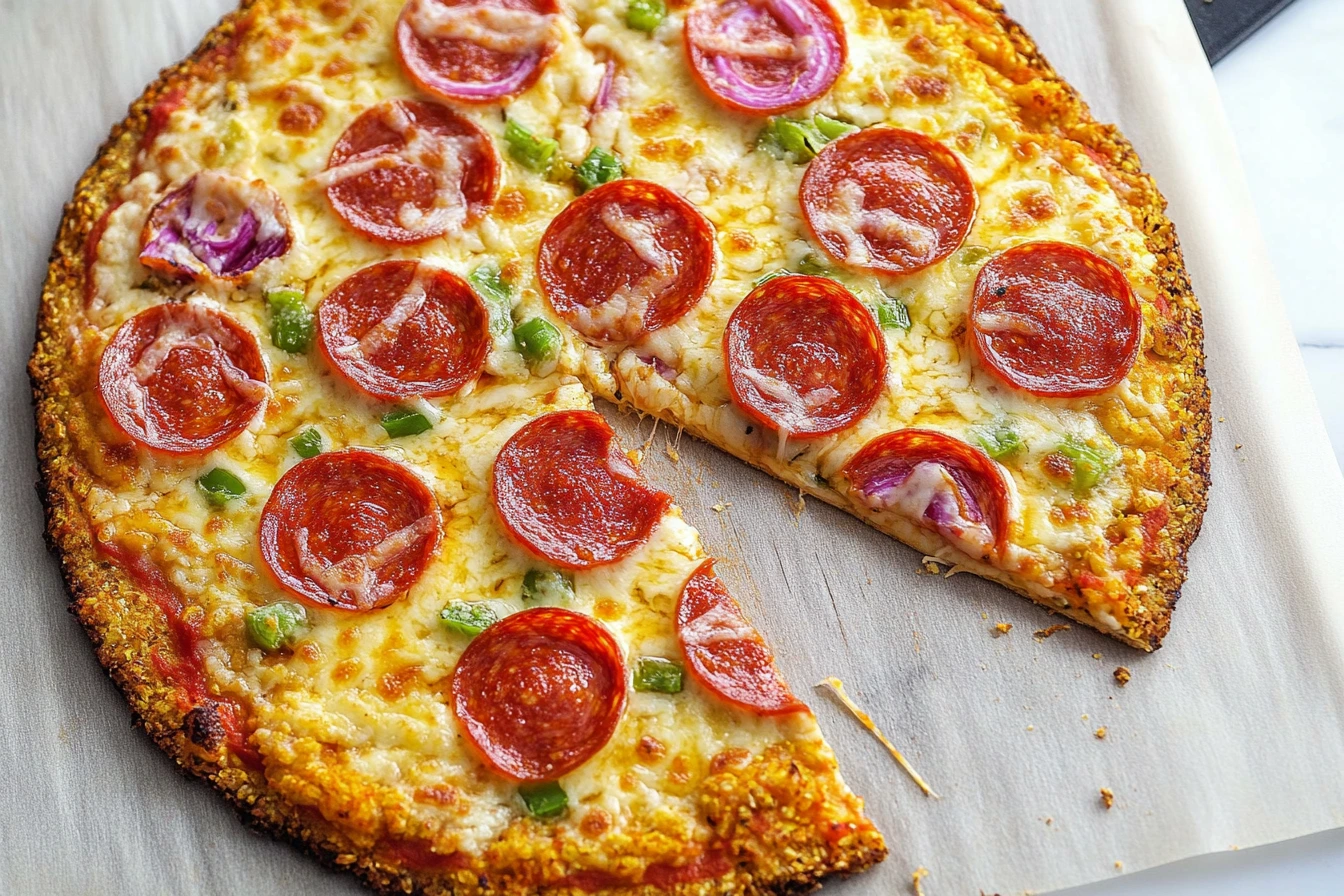In recent years, cauliflower crust pizza has become very popular. This is especially true for people who care about eating healthy. They want better pizza options, especially ones that are low in carbs.
Many people ask if this veggie-based crust is better than regular pizza bases. This article will look at its nutrition, health benefits, and taste. We aim to clear up any misunderstandings and explain why cauliflower crust pizza is so appealing.
A bright, freshly baked cauliflower crust pizza topped with colorful vegetables like bell peppers, spinach, and cherry tomatoes. It’s placed on a wooden table with a drizzle of olive oil and fresh herbs on top. A pizza slice is slightly pulled away, showing the unique texture of the cauliflower crust. The natural lighting makes the fresh ingredients stand out.
Key Takeaways
- Cauliflower crust pizza is a popular option among those seeking healthy food choices.
- This alternative is often lower in carbs than traditional pizza crusts.
- Health benefits may include increased fiber intake and a lower glycemic index.
- Potential drawbacks can arise from ingredient quality and allergens.
- Making homemade cauliflower crust pizza can enhance control over ingredients.
- A variety of healthy toppings can complement cauliflower crust pizza.
- This option may appeal to individuals following specific dietary needs.

Introduction to Cauliflower Crust Pizza
Cauliflower crust pizza has become very popular. It’s a great choice for those who want to enjoy pizza but don’t want to eat too much carbs. This introduction to cauliflower pizza shows a big change in what people eat, focusing on veggies instead of carbs.
Before, pizza crusts were made with white flour. But now, cauliflower is a big hit as a pizza crust. It makes pizza healthier and is found in many places, from restaurants to grocery stores.
Cauliflower is full of vitamins and minerals. It fits well with diets like Keto and Paleo, which are low in carbs. Cauliflower crust is tasty, healthy, and easy to find, making it a great choice for pizza lovers looking for something different.
What is Cauliflower Crust?
What is cauliflower crust? It’s a low-carb, nutritious pizza base made from grated cauliflower. It’s a healthier choice compared to traditional pizza dough. The main ingredients are cauliflower, cheese, and eggs.
These are mixed, shaped, and baked to create a strong base. It holds toppings well.
There are many cauliflower crust options available. Gluten-free ones are great for those with gluten sensitivities. Vegan options don’t have cheese or eggs.
Pre-made and homemade crusts differ in ingredients and nutrition. Making your own crust lets you control what goes into it. This can make it healthier and tastier.
Looking for pizza alternatives? There are many choices that fit your taste and health goals. Choosing the right cauliflower crust depends on your dietary needs and preferences. This ensures a great taste and experience.
Nutritional Comparison: Cauliflower Crust vs. Traditional Pizza Crust
It’s important to understand the differences in nutrition between pizza options. This section will compare cauliflower crust and regular pizza crust. We’ll look at calories, carbs, and vitamins to give a clear picture of their nutrition.
Calories and Carbs
Cauliflower crust has fewer calories than regular crusts. A slice of cauliflower crust pizza has about 60 calories. In comparison, regular crusts can have 150 to 200 calories. This makes cauliflower crust a better choice for people trying to lose weight or eat healthier.
Carbs also show a big difference. Cauliflower crust has about 4-5 grams of carbs per slice. Regular crusts can have over 30 grams. This shows cauliflower is a good low-carb choice.
Vitamins and Nutrients
The cauliflower crust is also full of vitamins and nutrients. It has vitamin C and vitamin K, which are good for your immune system and bones. Regular pizza crusts, made from white flour, don’t have as many nutrients. Picking cauliflower crust means you get a healthier meal.
Health Benefits of Cauliflower Crust Pizza
Cauliflower crust pizza is great for those who care about their health. Moreover, it’s not just tasty, but also nutritious. Therefore, let’s look at the main benefits of this dish.
Low-Carbohydrate Content
The low-carb diet advantages of cauliflower crust are clear. In comparison, it has much less carbs than regular pizza dough. As a result, this can help control blood sugar, especially for people with diabetes or on a low-carb diet.
Furthermore, it also helps reduce cravings and keeps energy levels stable. This is because it has fewer carbs.
Increased Fiber Intake
Cauliflower is a top high-fiber food. Specifically, its crust is full of dietary fiber. This is good for digestion and makes you feel full longer.
In addition, eating foods high in fiber, like cauliflower, can lower the risk of chronic diseases. Thus, it also improves gut health.
Lower Glycemic Index
Cauliflower crust pizza has a lower glycemic index than regular crusts. Consequently, this means it helps keep blood sugar levels stable. Foods with a lower glycemic index release glucose slowly, which is better for metabolism.
| Benefit | Cauliflower Crust | Traditional Pizza Crust |
|---|---|---|
| Carbohydrate Content | Low | High |
| Fiber Content | High | Low |
| Glycemic Index | Low | High |
Potential Drawbacks of Cauliflower Crust Pizza
Cauliflower crust pizza has become popular for its health benefits. But, it’s important to look at its drawbacks. Knowing these can help people make better choices.
Ingredient Quality
Commercial cauliflower crusts often have concerns about ingredients. Many brands add fillers and preservatives to improve texture and shelf life. These can reduce the nutritional value, making the crust less healthy than homemade ones.
Choosing brands with cleaner ingredients can help. But, it’s important to stay alert when shopping.
Possible Allergens
Some cauliflower crusts may contain common allergens. Cheese or nut flours are often used, which can be a problem for some. People with lactose intolerance or nut allergies should check labels to avoid issues.
Being aware of these allergens is key when enjoying cauliflower crust pizza.
Satiety and Fillingness
Pizza satiety is another important factor. Many find cauliflower crust less filling than traditional crusts. This can lead to eating more, which might not be good for those looking for a low-carb option.
Understanding your own satiety needs is crucial. It helps decide if cauliflower crust pizza is a good choice for you.

How to Make Your Own Cauliflower Crust Pizza
Making a cauliflower pizza at home is a fun and healthy way to enjoy pizza. It uses fresh ingredients and lets you pick your favorite toppings. This makes it great for people who want a healthier meal.
Ingredients:
- 1 medium cauliflower head
- 1/2 cup shredded mozzarella cheese
- 1/4 cup grated Parmesan cheese
- 1 egg
- 1 teaspoon garlic powder
- Salt and pepper
Directions:
- Heat the oven to 450°F (232°C).
- Cut the cauliflower into small pieces and steam it until soft.
- Grate the cauliflower using a grater or food processor until it looks like rice.
- Squeeze out the water from the grated cauliflower using a towel.
- Mix the cauliflower with mozzarella, Parmesan, the egg, garlic powder, salt, and pepper in a bowl.
- Spread the mixture on a baking sheet lined with parchment paper, making a thin crust about 1/4 inch thick.
- Bake for 12-15 minutes until the crust is golden brown.
- Add your toppings and bake for 5-10 more minutes.
Try adding your own favorite flavors and toppings. This way, you can enjoy a meal that is both tasty and good for you.
By making your own pizza crust, you can decide what goes into it. This means you can make it both healthier and better for your taste.
Store-Bought vs. Homemade Cauliflower Pizza
Deciding between store-bought and homemade cauliflower crust pizza depends on what you need. Both have good and bad points, but knowing these differences helps you choose what works best for your diet and taste.
Tips for Reading Nutrition Labels:
- Calories: Choose pizzas with fewer calories to keep your meals lighter.
- Ingredients: Look for short lists with simple items. Avoid brands with too many chemicals or fake flavors.
- Allergens: Check for gluten, dairy, or other items if you have allergies or special diets.
Making your own pizza gives you full control of the ingredients. This way, you can enjoy a meal that’s healthier and more flavorful.u can tailor it to your health goals. Here’s a table comparing some well-known store-bought cauliflower pizza brands.
| Brand | Calories per Serving | Main Ingredients | Allergen Information |
|---|---|---|---|
| Caulipower | 130 | Cauliflower, mozzarella cheese, rice flour | Gluten, Dairy |
| Inner Eco | 150 | Cauliflower, almond flour, eggs | Nuts, Eggs |
| Trader Joe’s | 110 | Cauliflower, part-skim mozzarella, cornmeal | Dairy |
By carefully evaluating and making informed choices, you can enjoy tasty and healthy meals. Whether you choose store-bought or make your own, you’ll have great options.
Popular Toppings for Cauliflower Crust Pizza
Choosing the right toppings for cauliflower crust pizza is key. It makes the pizza both tasty and nutritious. The right toppings can turn a simple meal into a special treat.
Healthy Options
Looking for healthy toppings? There are many options that taste good and are good for you. Here are some:
- Fresh Spinach – Full of vitamins A and C, spinach is a healthy choice.
- Lean Meats – Grilled chicken or turkey are good sources of protein without too much fat.
- Bell Peppers – They’re full of antioxidants and vitamin C, adding color and crunch.
- Mushrooms – Low in calories but high in vitamins, mushrooms add flavor.
- Herbs – Basil, oregano, or arugula boost flavor and offer health benefits.
Sourcing Quality Ingredients
To get the most health benefits from your pizza, choose quality ingredients. Fresh, organic produce and lean meats make a big difference. Local farmers’ markets and specialty butchers offer the best options.
These quality ingredients ensure your cauliflower crust pizza is not only delicious but also healthy. It supports a balanced diet.
A variety of colorful toppings for cauliflower crust pizza displayed artfully, featuring fresh vegetables like bell peppers, spinach, and cherry tomatoes, alongside proteins like grilled chicken and pepperoni. Include a sprinkle of mozzarella cheese, fresh basil leaves, and drizzle of olive oil on a rustic wooden table background.
Who Should Consider Cauliflower Crust Pizza?
It’s great for many diets. It’s perfect for those on low-carb diets. It has less carbs, making it a good choice for cutting down on carbs without giving up pizza.
It’s also good for people with gluten sensitivity. This pizza avoids wheat and gluten, making it safe to eat. Plus, it’s packed with veggies, adding nutrients to your meal.
Vegetarians and vegans will love it too. It’s a healthy, plant-based option. You can also make it fit into a healthy lifestyle by choosing the right toppings.
Conclusion
Cauliflower crust pizza is a healthier choice for anyone looking for a better pizza option. It has fewer carbs, more fiber, and a lower glycemic index. However, it’s important to think about the quality of ingredients and how it makes you feel.
Choosing cauliflower crust depends on your health goals and what you like to eat. It’s a great way to try new flavors and ingredients. Also, making your own crust lets you customize it to your liking, making it even healthier.
When choosing your pizza, experiment with different toppings and flavors. This way, you can enjoy a delicious meal that’s also good for your health. Whether you make it yourself or buy it, remember the benefits of cauliflower crust. It’s a smart choice for a healthier pizza.

Frequently Asked Questions (FAQs)
Is cauliflower crust pizza really healthier than traditional pizza?
Yes, cauliflower crust pizza is healthier. It has fewer calories and carbs, which makes it a great option for low-carb diets.
What ingredients are typically used in cauliflower crust?
Cauliflower crust is made with grated cauliflower, cheese, and eggs. Some recipes include extra spices. There are also gluten-free and vegan options available.
How does the nutritional content of cauliflower crust compare to traditional pizza crust?
Cauliflower crust has fewer calories and carbs compared to traditional crust. It also contains vitamins C and K.
What are the health benefits of eating cauliflower crust pizza?
Eating cauliflower crust pizza is good for you. It’s low in carbs, high in fiber, and has a low glycemic index. This helps manage blood sugar and supports digestion.

